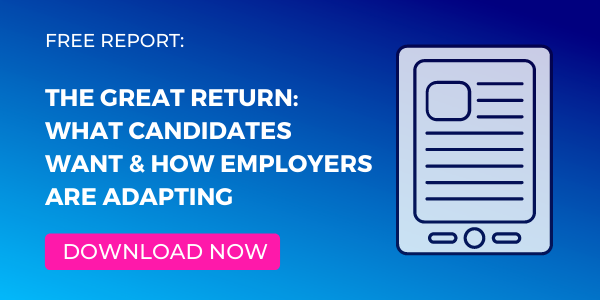It’s happening. Workers are slowly but surely returning to the office after months of pandemic-induced remote working. While a few days a week onsite might be fine, employees say they’re in no rush to return to the routine of five days in the office, 52 weeks a year. In a much-publicized survey, some even said they’d choose to permanently work at home rather than accept a $30,000 raise.
Employers will have to accommodate their desires, or at least meet them halfway. Hiring needs across tech are soaring, and with the possibility of remote work, talented employees can easily decamp to a company that will grant their wishes to work remotely.
That’s a high-level look at The Great Return: What Candidates Want & How Employers Are Adapting, Built In’s report on tech’s back-to-work dilemmas. It is based on two surveys, completed this spring, of tech professionals and tech companies. The surveys collected information on the tech community’s attitudes toward returning to work as well as employers’ efforts to orchestrate return-to-work strategies and remote work preferences for the long term.
What Employers Need To Know About Returning To The Office
- Flexible work options are no longer up for debate. Employees became accustomed to them during the pandemic and expect flexibility going forward.
- The competition for talent is heating up, and companies offering flexibility stand a better chance of nabbing top talent.
- Employers must listen to employees, or risk future problems. This is a golden opportunity for employers to listen to their workers and take their opinions seriously.
FREE REPORT: THE GREAT RETURN - WHAT CANDIDATES WANT & HOW EMPLOYERS ARE ADAPTING. DOWNLOAD NOW.
Results indicated a bit of a push-pull between what employees want and what employers want to offer, a situation complicated by the dire need for tech talent. For instance, not a single employee surveyed wants to return to work in an office five days a week, and more than half (53 percent) would prefer to work at home and use office space for team meetings.
The takeaway? Flexible work options are a must-have, not a nice-to-have, in these post-pandemic days. Yet despite that mandate from employees, 22 percent of employers surveyed are still on the fence about offering flexible work options in the future.
How Work Shifted During COVID
Before COVID-19, only 7 percent of employees surveyed were working 100 percent remotely. Now, only 3 percent are working in the office. Three-quarters of employees were forced to work from home during the pandemic, despite being near an office.
As for employers, 56 percent had zero remote workers pre-pandemic, and only 12 percent had more than half of their workforce remote. Fast forward to 2021: Only 21 percent of employers will have zero to nine remote employees, a huge drop from the 56 percent cited above. More than a quarter (27 percent) will have more than half their staff work remotely.
For employees, the pandemic normalized working from home, so much so that over the course of a year, “remote work” went from being the top benefit for employees to no longer placing in the top 10. The implication, of course, is that employees came to view remote work as a way of life, not as a company-provided benefit.

McKinlie Evans, an associate in project strategy for Chicago-based fintech company Avant, had never worked remotely prior to the pandemic. “It took some time getting used to collaborating and communicating with people remotely, and figuring out how to be productive,” she said. After a month or two, she began enjoying the time flexibility that remote working offers. “I like that you have the ability to focus and be flexible with your own schedule during the day,” she said.
Another consequence of the pandemic: Workers moved. Our survey indicates that 22 percent of employees relocated to be closer to family and friends, or for a different, preferred lifestyle. The ability to move gave employees a taste of freedom — no longer being “chained” to a certain location — and also a chance to assess what really matters in their lives.
The Post-COVID Office
What happened to the office during the pandemic can’t help but affect how it evolves as the world returns to normal. One outcome for employees: Almost half of companies (49 percent) said that new hires’ locations won’t matter any more.
That nonchalance will come in handy as tech companies prepare for a talent war. After staying put for a year or more, employees who wanted a new job pre-pandemic will begin to look for one. Our survey indicates that three-quarters of tech workers are “at least slightly likely” to job hunt in the next 12 months, and as many as half of workers plan to job hunt in 2021, according to a Society for Human Resource Management study. This means that companies who want the very best talent will need to give employees what they want in terms of flexibility.
What does that mean? It means asking employees what they want in a post-COVID workplace. Eighty-four percent of those surveyed have done so, or plan to, but only 21 percent said they’ll use employee preferences to guide their return-to-work strategies. And let’s not forget: Because of COVID, there’s more involved in the decision than simply where work will take place. Masks (to wear or not to wear?) and vaccinations (mandatory? highly recommended?) will also factor into the equation.
Tech companies will have to create return-to-work plans that accommodate employees as well as the need to run a business. Companies with multiple offices — and in our survey, more than half do — will likely have to devise different strategies for each location. At the same time, companies will find themselves in a talent war with competitors who are offering perhaps better flexibility to employees.
For more insights, and perhaps some guidance as the tech industry navigates this next year, take a look and download Built In’s report.
FREE REPORT: THE GREAT RETURN - WHAT CANDIDATES WANT & HOW EMPLOYERS ARE ADAPTING. DOWNLOAD NOW.




